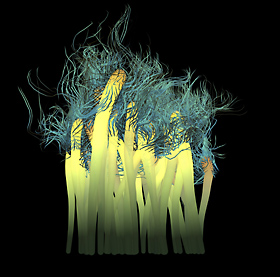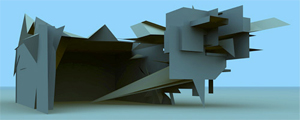Transforming Internet Trash into Art
|
 |
Dragulescu makes art out of one of the most reviled artifacts of the Digital Age — spam email — with a computer program he wrote for his master’s of fine arts thesis in visual arts. The program uses algorithms to convert junk messages into 3-D electronic "sculptures."
"Now, with Bayesian rules filters, most of the spam is removed from my inbox, but a year ago I was receiving almost 200 junk messages a day. It was a veritable psychological assault. Sometimes, though, I would take the time to read some of the messages, and I was immensely amused. It seemed these were written by the Dadaists 80 years ago or maybe a new form of automatic literature was happening right in my mailbox."
So instead of just discarding the spam, Dragulescu decided to take up the challenge of working with "found objects" that were always changing and evolving -- and use them as a source of inspiration and as data for visualization.
By assigning values and characteristics to the text found in these emails (so that the word "credit" signals a color, for instance), Dragulescu turns all-too-familiar come-ons for prescription drugs or hot tips about the stock market into things of beauty. These look architectural or botanical and are usually built or grown from a single email. In the example to the right, a message from a faux-pharmacy trumpeting "lowest prices" has been transformed into what appears to be a plant flowering underwater.
|
Dragulescu, who also uses blogs and bits of code underlying video games as materials, has worked with compositions by Mozart as well — turning the maestro’s music into vibrant “extrusions.” In the future, he plans to experiment with literature as a data source too. What, he wonders, would a plant derived from Shakespeare look like next to one that came from spam?
Related Links
Alex Dragulescu Website
Experimental Game Lab
Seoul International Media Art Biennale



